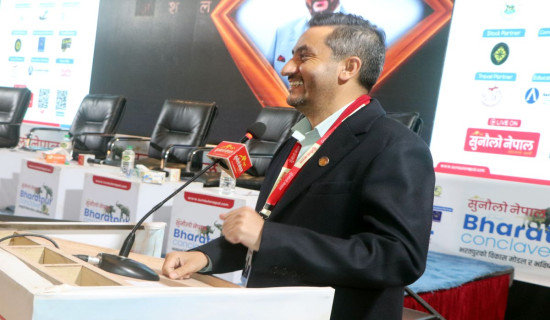- Friday, 2 January 2026
Nutritional Challenges Persist In Nepal
Nepal is grappling with the persistent challenge of malnutrition and confronts its formidable obstacles in improving nutritional outcomes, especially in low-income communities. Despite progress in recent decades in reducing poverty, improving health indicators, prioritising nutrition education, and expanding nutrition intervention programmes, malnutrition remains a pressing concern.
According to the Nepal Demographic and Health Survey (NDHS) 2022, based on BMI for age, 41 per cent of men in the 15-49 age groups are lean. Similarly, 34 per cent of women between the ages of 15 and 49 are anaemic overall, 18 per cent are moderately anaemic, 15 per cent are severely anaemic, and 1per cent are seriously anaemic. Similarly, the prevalence of malnutrition among under-5 children is still high in Nepal and remains a significant public health challenge, despite efforts to address it over the years. A recent study in 2024 reveals the most prevalent form of malnutrition in Nepal is stunting (36 per cent), followed by underweight (27 per cent), and wasting (10 per cent). These rates indicate chronic and acute malnutrition and reflect inadequate nutrition and health care.
On the other hand, overnutrition has also been a great threat in the past few decades. Research indicates that between 2011 and 2016, the percentage of women aged 15 to 49 who were overweight or obese rose from 3 per cent to 21 per cent. Similarly, current statistics show 17 per cent of men aged 15-49 years are overweight or obese.
Challenges
Food security, including nutritional issues, is not only related to the individual's personal life but also the capacity, productivity, and creativity of the state. Poverty is a significant issue in Nepal, as the percentage of people living in poverty is close to 25 per cent. Individuals with low economic conditions have limited resources, which makes it difficult for them to get enough food that is nutritious and sufficient. In 2022, there were 27 deaths before the age of five for every 1,000 births in Nepal. Although the level of hunger is moderate in here, it still exists. Therefore, there is a crucial connection between poverty and malnutrition. Nepal's poor road condition creates a challenge to transport and distribute food, especially to rural and remote areas, which leads to isolating those communities with limited access to markets and food supplies.
The country is highly vulnerable to natural disasters such as earthquakes, floods, landslides, and droughts. These incidents can destroy agricultural production, disrupt food supply chains, and destroy infrastructure. Traditional diets often lack diversity, with heavy reliance on staples like rice and lentils, which might not provide all essential nutrients.
Likewise, cultural or religious practices might restrict the consumption of certain foods, leading to deficiencies. Cultural beliefs about food consumption can lead to low nutritional status, particularly for highly sensitive groups such as pregnant, lactating women and children. Due to limited health literacy, people lack basic knowledge regarding nutrition, including the importance of a balanced diet. Similarly, it also leads to difficulty in understanding health and nutrition information, which includes food labels and dietary guidelines.
Similarly, many rural and remote areas lack sufficient health care facilities. With limited health infrastructure, preventive health services are impossible, which are very crucial for preventing malnutrition and ensuring healthy development.
Efforts to reduce malnutrition are also hampered by inadequately skilled healthcare providers, especially in rural areas and low-income groups. There is a critical health worker shortage in Nepal, with only 0.67 doctors and nurses per 1000 population, which is significantly smaller than the WHO recommendation of 2.3 doctors, nurses, and midwives per 1000 individuals.
Solutions
Health and food security are matters of the government's responsibility. It is also the responsibility of the government to ensure the right to health, food, and social security provided by the constitution of Nepal. In this context, the following activities can be important for ensuring food security, including nutrition for the economically weaker sections of society.
To address nutritional issues in Nepal, income-generating activities can play a crucial role by improving the economic conditions of families and communities. Expanding social safety nets, such as cash transfers and food aid, is essential to support vulnerable populations. Promoting livestock raising, kitchen gardens, and diverse crop cultivation can increase food security and dietary diversity.
Additionally, implementing programs to fortify staple foods with essential vitamins and minerals, such as iodised salt and fortified flour, is vital. Conducting community-based nutrition education programs in both rural and urban areas can raise awareness about the benefits of a balanced diet and healthy eating practices. Providing nutritious meals in schools can improve child health and educational outcomes.
Enhancing the capacity of healthcare facilities and conducting training programs for healthcare workers is also important to deliver effective nutritional programs. Finally, engaging local communities in designing and implementing these programs ensures cultural relevance and sustainability.
Conclusion
In summary, poverty, geographical barriers, cultural restrictions, and inadequate health literacy all contribute to nutritional challenges. Different progress has been made through comprehensive strategies, interventions, and initiatives; however, nutritional challenges still remain a pressing issue. Nepal has implemented a wide range of nutrition-related policies and strategies that have addressed undernutrition and improved food security, whereas very few have emphasised overnutrition and other diet-related issues. So, these issues must also be addressed, and important problems like hunger, malnutrition, and restricted access to wholesome food require coordinated actions from the public sector, non-governmental organisations, and local communities. Enhancing healthcare services, ensuring equitable resource allocation, providing income-generating activities, prioritizing nutrition education, and fostering agricultural diversity are some of the solutions. Similarly, there is also a need to strengthen the strategies for children from socio-economically deprived areas to reduce the burden of child malnutrition. Most policies lack a clear mechanism to effectively implement and monitor progress. Thus, these gaps should also be addressed. The combined effort is very essential to overcome nutritional challenges and to ensure a healthier, more vibrant future for all.
(Koirala is pursuing bachelors of Public Health Programme at Nobel College, Kathmandu.)















